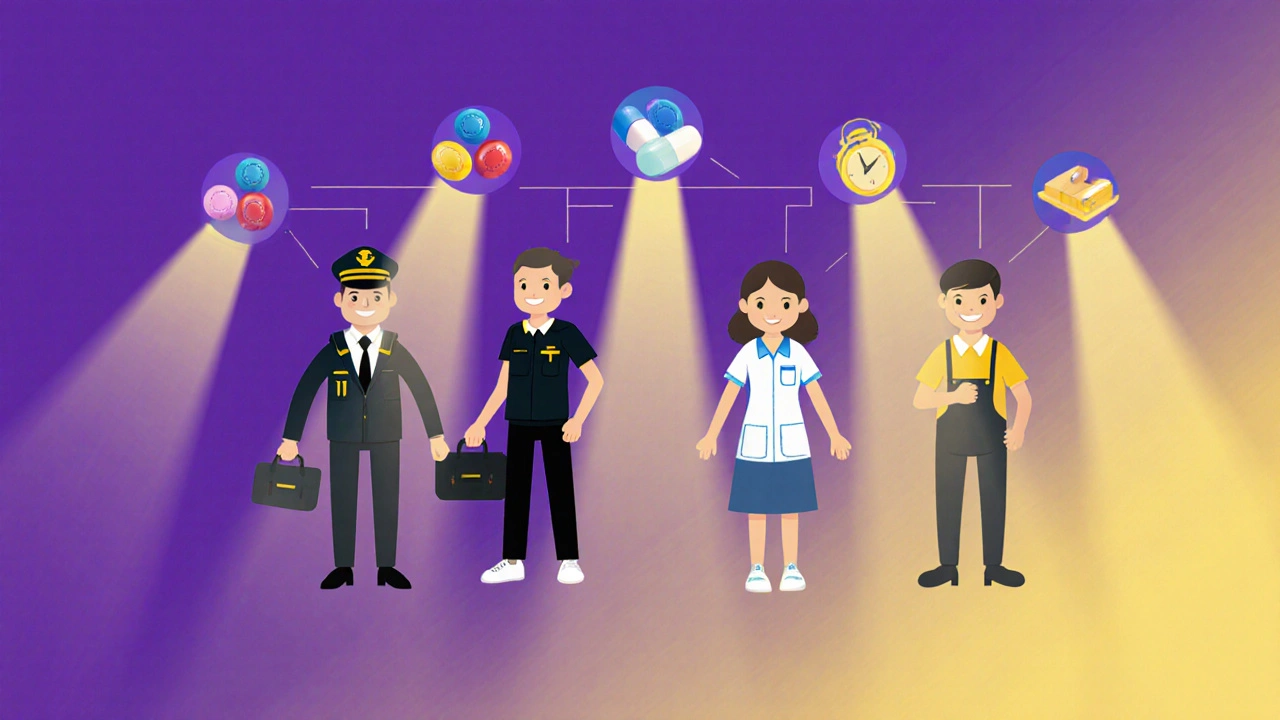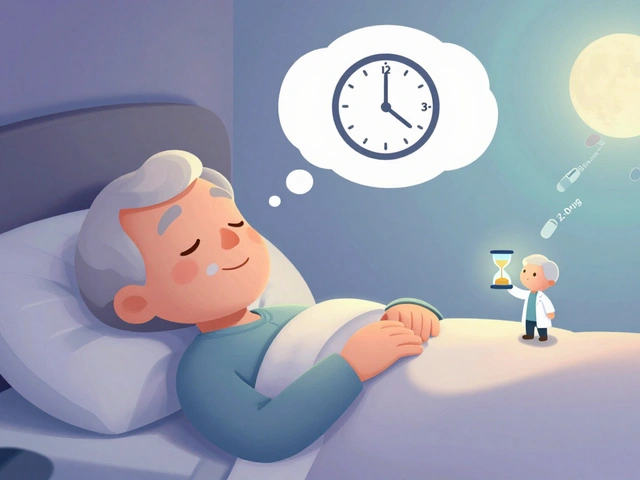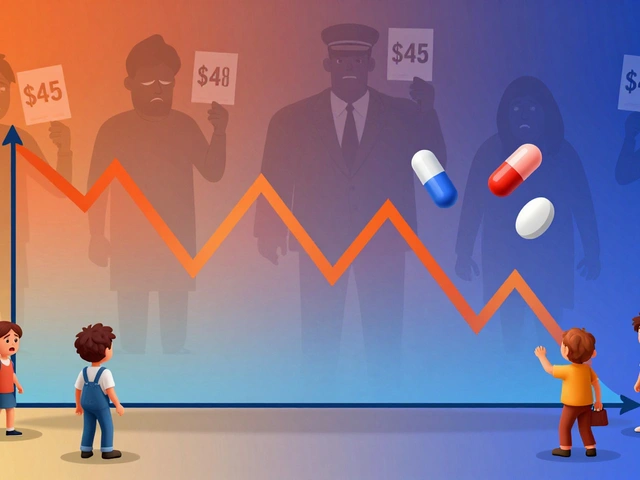Antihistamine Safety Calculator
Is Your Antihistamine Safe at Work?
First-generation antihistamines (like Benadryl) impair reaction time without causing drowsiness. Second-generation options (like Claritin) are safer for safety-sensitive jobs.
Every year, thousands of workers take antihistamines for allergies - not knowing they’re putting themselves and others at risk. You might feel fine after popping a Benadryl, but your brain isn’t working the same. Reaction times slow. Focus slips. You don’t feel sleepy, but you’re not fully awake either. That’s the dangerous illusion created by first-generation antihistamines, and it’s costing lives on roads, in factories, and in the skies.
Why You Don’t Feel Sleepy, But You’re Still Impaired
First-generation antihistamines like diphenhydramine (Benadryl), chlorpheniramine (Chlor-Trimeton), and hydroxyzine (Atarax) were designed to block histamine, the chemical that triggers sneezing and itchy eyes. But they also cross the blood-brain barrier easily. Once inside, they interfere with histamine’s natural role in keeping you alert. The result? Cognitive impairment without the warning sign of drowsiness. Studies show these drugs can reduce reaction time by 25-30% and increase lane deviation by 50% in driving simulators. That’s worse than being legally drunk in some cases. And it’s not just drivers. Pilots, construction workers, machine operators, and nurses have all been found impaired after taking these meds - even when they swear they’re fine. The problem isn’t just the drowsiness. It’s the lack of awareness. A commercial truck driver on Reddit took diphenhydramine for allergies, didn’t feel tired, but failed a roadside cognitive test. He couldn’t touch his nose with his finger. He didn’t know he was impaired until it was too late.Second-Generation Antihistamines: The Safer Alternative
There’s a better option: second-generation antihistamines like loratadine (Claritin), cetirizine (Zyrtec), fexofenadine (Allegra), and bilastine. These were specifically engineered to stay out of the brain. They bind to P-glycoprotein transporters, which pump them back out before they can slow down your thinking. The difference is measurable. In clinical trials, second-generation antihistamines show impairment levels almost identical to a placebo. A 2013 study in PubMed found that drivers taking these medications performed just as well as those who took nothing at all. Meanwhile, users report far fewer side effects. On Healthgrades, 78% of Allegra users say they experience no drowsiness. Only 12% of Benadryl users say the same. And it’s not just about feeling alert - it’s about safety. First-generation antihistamines are the most common medication found in the blood of pilots who died in crashes. Second-generation drugs? Almost never. The FAA bans sedating antihistamines for pilots. The DOT requires employers in transportation to track their use. Why? Because the data doesn’t lie.The Hidden Costs in the Workplace
This isn’t just about car accidents. It’s about falls, errors, and lost productivity. The CDC reports that over one in four older adults fall each year - and first-generation antihistamines are a major contributor. In manufacturing and construction, a momentary lapse in attention can mean a trip, a fall, or a crushed finger. Nurses working night shifts report improved alertness after switching from diphenhydramine to loratadine. One nurse said, “I noticed right away - I could stay focused during procedures without crashing after lunch.” Employers are starting to take notice. As of 2023, 41% of Fortune 500 companies include antihistamine use in their occupational safety policies. That’s up from almost zero five years ago. Why? Because they’ve seen the cost: increased workers’ compensation claims, higher insurance premiums, and lost work hours from impaired performance. Even students aren’t immune. A 2001 study by Dr. G.G. Kay found that sedating antihistamines reduce learning capacity. If you’re taking Benadryl for allergies and struggling to concentrate in class, it’s not just you - it’s the drug.
Timing and Dosing: When It’s Still Dangerous
Some people think taking antihistamines at night solves the problem. But it doesn’t. First-generation antihistamines have half-lives of 15 to 30 hours. That means if you take one at 8 p.m., you could still be impaired at noon the next day. The FDA recommends taking them at bedtime - but that advice doesn’t account for shift workers, night crews, or anyone who needs to be sharp during the day. The National Sleep Foundation recommends waiting at least 24 hours after taking a sedating antihistamine before operating heavy machinery or driving. That’s not an exaggeration. Peak impairment hits 2-4 hours after ingestion, but residual effects linger for up to 18 hours. Combine that with alcohol, sleep deprivation, or other sedatives, and the risk multiplies. The label on Benadryl warns about this - but most people ignore it.What You Should Do - Right Now
If you take antihistamines regularly and work in a safety-sensitive job - driving, operating equipment, handling tools, working at heights - here’s what you need to do:- Check the active ingredient. If it’s diphenhydramine, chlorpheniramine, or hydroxyzine - stop. Switch.
- Switch to loratadine, cetirizine, or fexofenadine. These are widely available over the counter and just as effective for allergies.
- Test it first. Take a new antihistamine at home before work. See how you feel. Can you focus? Can you react quickly? Don’t assume you’ll be fine.
- Don’t rely on how you feel. Impairment doesn’t always come with yawning or heavy eyelids. It comes as slowed thinking, poor coordination, and delayed reactions - things you won’t notice until it’s too late.
- Talk to your doctor. If you’re prescribed a sedating antihistamine, ask if a non-sedating alternative is available. Many doctors still default to older drugs out of habit.

The Bigger Picture: Why This Isn’t Just Personal
This isn’t about being “responsible.” It’s about systems. The FDA mandated clearer warning labels on sedating antihistamines in March 2023. The European Union issued safety alerts for transport workers in 2019. NIOSH launched a workplace safety initiative in 2024. These aren’t random policy changes - they’re responses to real data, real injuries, and real deaths. And the market is shifting. Second-generation antihistamines now make up 68% of the global market. Why? Because people are choosing safety. Employers are demanding it. Insurance companies are penalizing risky behavior. If you’re still using Benadryl for allergies, you’re not just risking your own safety - you’re risking the safety of coworkers, passengers, and strangers on the road. That’s not a choice. It’s negligence.What’s Next?
The trend is clear: workplaces will increasingly require non-sedating antihistamines for safety-sensitive roles. By 2026, it’s likely that companies will ban first-generation antihistamines outright for drivers, pilots, and heavy equipment operators. The American College of Occupational and Environmental Medicine estimates that 23 million American workers use antihistamines regularly. Most of them don’t know they’re putting themselves in danger. The fix is simple: stop using sedating antihistamines. Start using the ones that don’t cross the blood-brain barrier. Your brain will thank you. So will everyone around you.Do all antihistamines make you drowsy?
No. Only first-generation antihistamines like diphenhydramine, chlorpheniramine, and hydroxyzine cause significant drowsiness because they enter the brain. Second-generation antihistamines like loratadine, cetirizine, and fexofenadine are designed to stay out of the central nervous system and typically cause no drowsiness.
Can I drive after taking Benadryl if I don’t feel sleepy?
No. Even if you don’t feel sleepy, Benadryl impairs reaction time, coordination, and decision-making. Studies show drivers on Benadryl perform as poorly as those with a blood alcohol level of 0.05%. The FDA and NHTSA both warn against driving after taking it, regardless of how you feel.
How long does drowsiness from antihistamines last?
First-generation antihistamines can impair you for up to 18-24 hours after a single dose. Peak impairment occurs 2-4 hours after taking it, but residual effects linger. Second-generation antihistamines typically wear off within 8-12 hours and rarely cause next-day drowsiness.
Are there laws against driving on antihistamines?
Yes. In the U.S., all 50 states have laws that prohibit driving under the influence of any drug that impairs your ability to operate a vehicle safely - including sedating antihistamines. You can be charged with DUI even if the drug is legal and prescribed.
What should I do if my doctor prescribes a sedating antihistamine?
Ask if a non-sedating alternative is available. Many doctors prescribe diphenhydramine out of habit, not because it’s the best choice. Loratadine, cetirizine, and fexofenadine are equally effective for allergies and much safer for daily use, especially if you work in a safety-sensitive job.
Can I take antihistamines if I work night shifts?
Only if you take a non-sedating version. Taking diphenhydramine before a night shift may make you fall asleep at your post. Even if you take it after your shift, it can linger into your next workday. Second-generation antihistamines are safe to take anytime - even during work hours - without impairing alertness.




Conor McNamara on 17 November 2025, AT 14:54 PM
they been putting this in the water since the 90s. you think its about allergies? nah. its about keeping us docile. benadryl makes you slow, forgetful, easy to control. the fda? theyre in on it. same people who let aspartame through. i stopped taking anything with diphenhydramine after my cousin got fired for failing a sobriety test-turned out he took a sleep aid. they called it drunk driving. he lost his license. his job. his house. all because the label said "take as needed".